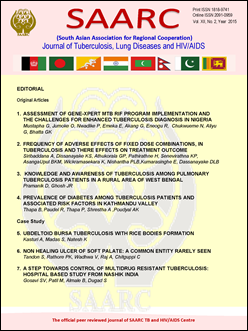Frequency of Adverse Effects of Fixed Dose Combinations, in Tuberculosis and there Effects on Treatment Outcome
DOI:
https://doi.org/10.3126/saarctb.v12i2.15949Keywords:
Tuberculosis, Fixed Drug Combinations, Adverse Reactions, Alternative RegimesAbstract
Introduction: This study was designed to assess the frequency, types and impact of adverse drug reactions (ADR) to category 1 anti-tubercular therapy using fixed drug combinations (FDC). Patients with tuberculosis started on anti TB treatment from 01st of July 2011 to 30th of June 2012 were recruited
Methodology: Patients were followed up for development of ADR. Frequency of ADR, number of patients who required prolongation of therapy, who had alternate regimes, and there treatment outcome were recorded.
Results: Out of 280 patients with tuberculosis 67 (24%), 37 (55.2%) males, 30 (44.8%) females ADR. Thirty three out of 74 (44%) of total population above the age of 60 had ADR, while only 34 out of 206 (16.5%) of patients below the age of 60 had ADR (Chi= 23, p <0.0001). Incidence of ADR were - Dyspeptic symptoms 31(11.1%), itching 20 (7.1%), hepatitis 9 (3.2%), arthralgia 1 (0.4%), vertigo 1 (0.4%), peripheral neuropathy 1 (0.4%), visual impairment 1 (0.4%), rash 1 (0.4%). Out of 27 patients who had prolongation of therapy 22 (81.4%) were due to ADR (Chi = 54, p <0.0001). Nine (3.2%) were given alternate regimes (Fishers exact p = 0.000017) [6 hepatitis, 1 rash, 1 vertigo, 1 visual impairment]. None of the patients with ADR had relapses or treatment failures.
Conclusion: Adverse reactions were commoner among the elderly, and were associated with prolongation and modification of anti tuberculosis therapy but over all treatment outcomes were not adversely affected.
SAARC J TUBER LUNG DIS HIV/AIDS, 2015 XII (2),Page: 8-12
Downloads
Downloads
Published
How to Cite
Issue
Section
License
Copyright © SAARC Tuberculosis and HIV/AIDS Centre (STAC), all rights reserved, no part of this publication may be reproduced, stored in a retrieval system or transmitted in any form or by any means without prior permission of the STAC.





